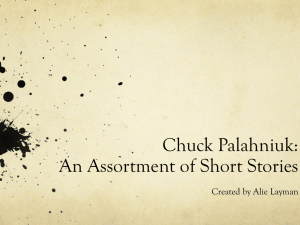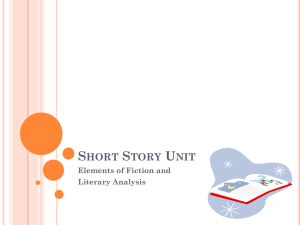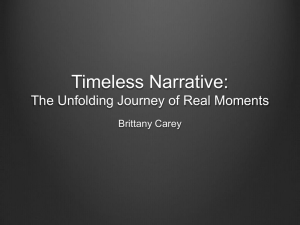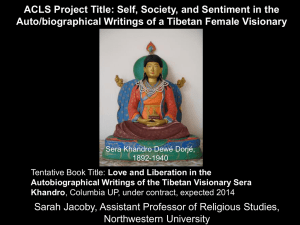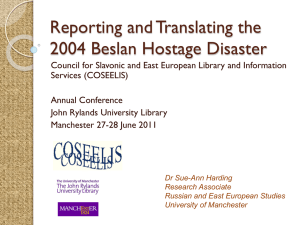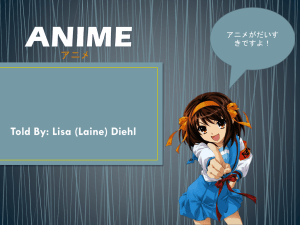Narrative in the Digital Age: From *Light Novels* to Web Serials
advertisement
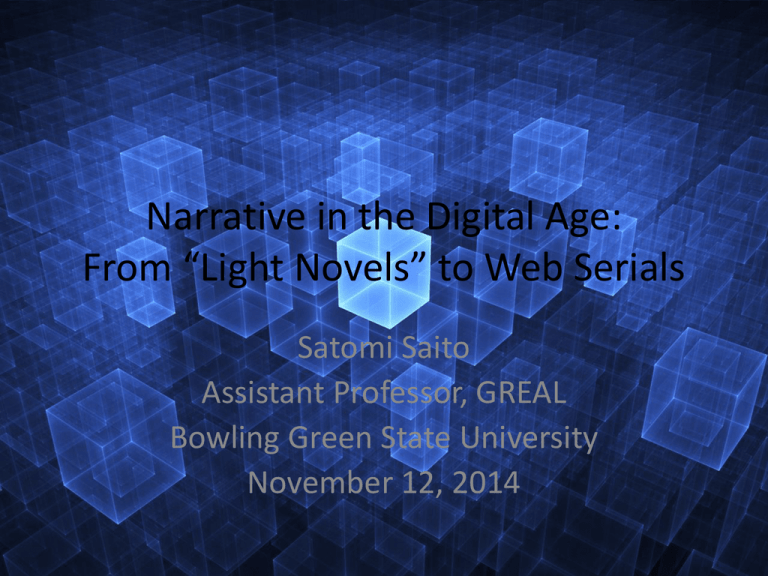
Narrative in the Digital Age: From “Light Novels” to Web Serials Satomi Saito Assistant Professor, GREAL Bowling Green State University November 12, 2014 Outline • Why light novels? – From old media to new media • History of young adult fiction in Japan – From Children's literature to young adult fiction • Media mix in 1980s – Light novels • Participatory Culture in 21C – Web serials Why Japanese Popular Literature? • Literature: Literary conventions specific to Japan – The I-novel as Japanese mode of writing (Otsuka) • Philosophy: A reflection of changing society reality – Postmodernism (Azuma) • Cultural Studies: Cultural conventions seen in popular literature – The Majority of Western media Culturist Interpretation Everywhere “Japanese myths often use shape-shifting, in which bodies reveal themselves as facades concealing a deeper reality. It's as if animation was invented for shape-shifting, and Miyazaki does wondrous things with the characters here.” Roger Ebert on Hayao Miyazaki’s Spirited Away (2002) How media traverse the globe? • Media influence vs. Cultural appropriation – Cultural (Western media) influence – Borrowing to maintain (Japanese) cultural heritages • Culture as our limits of imagination – Benedict Anderson, Imagined Communities. – Dissemination of cultures in the global market – Creation and maintenance of incommensurable differences – Learn from similarities rather than differences Theoretical Notes • Remediation – Jay David Bolter and Richard Grusin, Remediation: Understanding New Media (MIT Press, 2000) • Imaginary World Building – Mark J. P. Wolf, Building Imaginary Worlds: The Theory and History of Subcreation (Rutledge, 2012) • Japanese discussion of media-mix – – – – Azuma Hiroki, Otaku (U of Minnesota P, 2009) Otsuka Eiji, “World and Variation,” Mechademia 5 (2010) Ian Condry, The Soul of Anime (Duke, 2013) Mark Steinberg, Anime’s Media Mix (U Minnesota P, 2012) Remediation • Remediation – The representation of one medium in another – “Like their precursors, digital media can never reach this state of transcendence, but will instead function in a constant dialectic with earlier media, precisely as each earlier medium functioned when it was introduced” (Bolter & Grusin, p.50). • Immediacy – “In formal terms, the desire for immediacy is the desire to get beyond the medium to the objects of representation themselves” (p.83). cinema • Hypermediation – A “style of visual representation whose goal is to remind the viewer of the medium” (p.272). collage, CNN, first person shooting games – A visual style that “privileges fragmentation, indeterminacy, and heterogeneity and . . . Emphasizes process or performance rather than the finished art object” (W. Mitchell, The Recofigured Eye, p.8). Two moves of remediation • “Transparent digital applications seek to get to the real by bravely denying the fact of mediation” (Bolter & Grusin, p.53) virtual reality • “Digital hypermedia seek the real by multiplying mediation so as to create a feeling of fullness, a satiety of experience, which can be taken as reality” (Bolter & Grusin, p.53) WWW How to define Light Novels? • The term came out from user participation – Coined around 1990 by Kamikita Keita, who was the system operator of the Science Fiction and Fantasy forum in the Nifty Serve BBS; actual circulation around 2004 • Marginalized from more clearly defined genre fiction by serious fans and early adaptors (interact with technology/new media) • not young adult fiction, not a genre in a conventional sense (Genre function) • One of the most competitive Japanese “literature” in Japanese as well as in the global market A Genealogy of Affiliations (not a linear history) of Light Novels • Children’s Literature (児童文学 Jido bungaku) • Young Adult Fiction – Juvenile (ジュブナイル jubunairu) – Junior Fiction (ジュニア小説 junia shosetsu) • “Light Novel” (ライトノベル raito noberu) Boys Magazine: Shonen Sekai (1895-1933) Girls Magazine Shojo Sekai (1906-31) Children’s Literature • A strict gender division • To improve children’s literacy • To lift the morale of the nation; patriotism – Military and adventure themes for boys – Romance themes for girls; Good wife, Wise mother • A top-down imposition of state ideologies Print Capitalism and Westernized Liberal Arts • Bunko or Bunko-bon: small-format paperback books (A6), affordable, portable, modeled after Reclam universal library in Germany • Iwanami bunko (1927- ): classic works of domestic and foreign authors • Shicho bunko (1928- ): focus on world literature • Kadokawa bunko (1949- ): focus on Japanese literature in the early stage, shifted to popular literature in the 1970s Kadokawa Media Mix: the “synthetic” use of media The Third bunko boom • Kodansha bunko (1971- ) • Shueisha bunko (1977- ) Bunko Hardbacks 1972 8.1% 33.1% 1973 10.7% 28.4% 1974 14.0% 27.4% Sonorama bunko (ソノラマ文庫, 1975-) Kobaruto bunko (コバルト文庫, 1976- ) (Multi-media) New Currents • Girls: Shojo manga – Hagio moto Oshima Yumiko • Boys: Anime and games – Anime novelization – RPG replays! Hana no nijūyonen-gumi • Year 24 Flower Group (花の二十四年組): • Women manga artist groups considered to have revolutionized shōjo manga. Many of them were born in Shōwa 24 (1949) and started their career in the 1970s. • Shōjo manga • Hagio Moto, Poe no ichizoku (The Poe Family, 1972-76) • Ikeda Riyoko, Berusaiyu no Bara (The Rose of Versailles, 1972-1973) • Takemiya Keiko, Kaze to kino uta (The Poem of Wind and Trees, 1976-84) • Cf. Shōnen manga • Chiba Tetsuya, Ashita no Jō (Tomorrow’s Joe, 1968-73) Shōjo manga • Men’s logic and linearity in time/space and panels: uniformly regimented rectangles and rows, immediacy, cinema • Women’s emotion, interiority: time and reality were no longer locked up inside boxes and narratives could shift in and out of memories and dreams, hypermediation, novel How to represent interiority of shojo? Himuro Saeko and manga realism Novels that resemble manga • Dialogue and frequent line breaks dominate • An upbeat tempo of the dialogue drives the story forward • Settings are unrealistic and the content is selfconsciously empty (cartoonish reality) • when description is required, illustrations are inserted to supplement the reader’s imagination (practical ways of writing a few books per month) Boys: from media adaptation to remediation Game replay? • Mizuno Ryo, Record of Lodoss War (1988- ) – Originally created in 1986 as a Dungeons & Dragons “replay” and serialized in the computer magazine Comptiq. – Published as a novel in 1988 by Mizuno Ryo – Third person narration – Subcreation comparable to The Lord of the Rings The birth of “Light novel” • Kanzaki Hajime, Slayers (1989-2000) – a merger of Mizuno’s fantasy world making and Himuro’s writing style – First person narrative – Less dependent on the world making (inconsistency, parallel worlds) – References to the primary world (hypermediacy) • Manga/anime realism vs. conventional realism • Story oriented to character oriented David Bordwell’s Classical Hollywood Style: 1917-1960 I: A system of narrative logic 1. consists of at least two lines of action, one of which involves heterosexual romantic love 2. two lines coincide at the climax 3. the heterosexual relationships that give a sense of closure to otherwise unmotivated or even inadequate plot resolutions II: A system of cinematic time III: A system of cinematic space Story/Character/World • Novels as part of character merchandizing • Adaptation vs. character fiction – Mizuno: creation of the “unique” world – Kanzaki: creative appropriation of clichés • Character Fiction=light novels? • The primacy of characters in media mix – Mark Steinberg, Anime’s Media Mix. • The primacy of world in media mix – Ian Condry, The Soul of Anime. Narrative Consumption • Instead of narrative/story, what do we consume? • Otsuka Eiji, Narrative Consumption (1989) • The fragmentary attempt to approach a certain totality which is hidden from view (grand narrative, world view) Bikkuriman Stickers (1985) character + “small” narrative What do children consume? chocolate? the stickers? • 1. Every sticker contained the drawing of one character. On the reverse side of the sticker there was a short bit of information called “Rumors of the Devil World,” describing the character drawn on the front of the sticker. • 2. With one sticker alone this information amounted to little more than noise. But once the child had collected a number of them and put them together, the child began to vaguely see a “small narrative” emerging—the rivalry between characters A and B, the betrayal of D by C, and son on. • 3. This unexpected appearance of narrative functioned as a trigger to accelerate children’s collection. • 4. Moreover, with the accumulation of these small narratives, a “grand narrative” reminiscent of a mythological epic appeared. • 5. Child consumers were attracted by this grand narrative, and tried to gain further access to it through the continued purchase of chocolates. (Otsuka, “World and Varieties” p.106) Grand Narrative and Small Narratives • This will perhaps be easiest to understand if it is compared to a computer game. The totality of the data programmed into one video game would correspond to the worldview. [. . .]. By contrast to this, each individual drama corresponds to one game play. Each individual “play” using the same video game will offer up a different development depending on the player and the game. (Otsuka, p.108) World making vs. Story telling • Consistency and completeness of the secondary world (creator centered) • “While completeness can never be achieved, a sense of completeness can” (Wolf, p.61) trans-media storytelling • Story oriented to character oriented • The secondary world as a shared database • Gaps in the secondary world encourage participation (user centered) Bishojo Games remediate “light novel” “The Japanese word bishoujo (or bishojo) translates to ‘pretty girl’ and bishoujo games have been defined as ‘a type of Japanese video game centered around interactions with attractive anime-style girls’” (Matthew T. Jones, “The Impact of Telepresence on Cultural Transmission through Bishoujo Games,” p.294). The embodiment of database in style/narrative/ consumption. The sensibility of a “depth” of another kind “Dismantling the preceding works into some elements or fragments and reassembling them repeatedly rather than expressing their own authorship or originality” (Azuma). A belief in a single story which is in definition generated through a combination of multiple “choices.” Split subjectivity between surface (story) and depth (database): Hypermediation Yu-No (Elf, 1996) How to remediate Bishojo Games? • Yumizuru Izuru, IS<Infinite Stratos> (2009- ) • A male-oriented Harlem series: multiple characters as small narratives • Hypermediality: the story is subordinate to the characters • First person narration who plays the role of a simpleton who believes “they do not love me” = the player character • The reader as the subject who knows “they love him” = the player Reverse Harlem Otuka Eiji Narrative Consumption Creator-oriented world Azuma Hiroki Database Consumption User-oriented world Webserials • The user-generated content sites – – – – Arcadia; Derivative work, fan fiction Shosetsuka ni naro; creative original work Nocturne novels; adult novels (male) Moonlight novels; adult novels (female) • From the parasitic world (to media producers) to the autonomous world by grassroots users • Keywords, ranking, reviews, recommendations Characteristics of web serials • Parallel worlds – New Game + – Reincarnation • Cheating: secretly subverting the rules of the game to gain advantage over an opponent • First person limited perspective • Recycle of common settings – Parallel access to first and secondary world – Creative appropriations of clichés • Genre function: interpretive community BBS Maoyu • The original story was posted in a play format on the textboard 2ch in 2009. • Rely not on illustrations for description but on the shared database of RPG games • User participation in its narrative continuity Tono Mamare, Maoyu (2010) Japonism revisited • Immediacy = the West – representation • Hypermediacy = Japan? – Presentation • Discipline as interpretive communities
